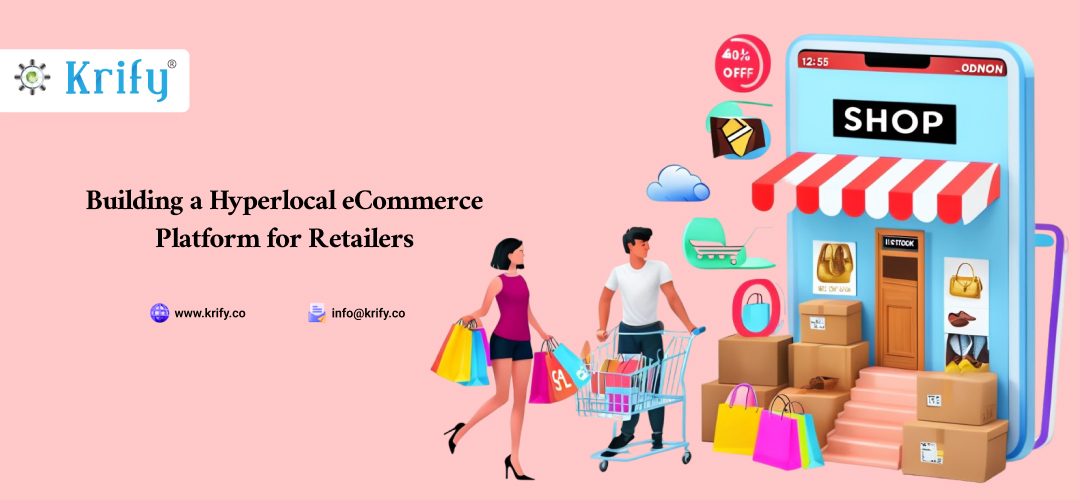The rise of hyperlocal eCommerce platforms has redefined how retailers connect with their customers. These platforms enable local businesses to offer products to nearby customers while leveraging digital technology for a seamless shopping experience. By catering specifically to customers within a limited geographic radius, hyperlocal eCommerce platforms enhance service delivery speed, ensure product availability, and personalize customer interactions.
What Is a Hyperlocal eCommerce Platform?
A hyperlocal eCommerce platform focuses on connecting local customers to nearby retailers, using geolocation technology to streamline shopping within a defined area. These platforms help small and medium retailers stay competitive by providing customers with the convenience of online shopping while promoting local commerce. Not only does this benefit customers through faster delivery and localized inventory, but it also strengthens community ties by supporting local businesses.
Benefits of Hyperlocal eCommerce for Retailers
Retailers can reap several advantages by adopting a hyperlocal eCommerce model:
1. Faster Deliveries: Unlike traditional eCommerce platforms that ship from distant warehouses, hyperlocal platforms utilize local inventory, significantly reducing delivery times.
2. Lower Shipping Costs: Delivering locally minimizes logistical expenses, which translates into lower shipping costs for retailers and more affordable options for customers.
3. Enhanced Customer Engagement: Being closer to their customers allows retailers to offer personalized services, enhancing brand loyalty and customer satisfaction.
4. Increased Foot Traffic: Hyperlocal platforms often include an option for in-store pickup, which can increase foot traffic to brick-and-mortar stores.
5. Competitive Advantage: Local retailers can compete with larger brands by providing a more personalized, community-focused experience.
Key Features of a Hyperlocal eCommerce Platform
For retailers, a successful hyperlocal eCommerce platform must include:
1. Geolocation Services: Essential for connecting nearby customers with local stores, geolocation technology personalizes the shopping experience by displaying location-specific options.
2. Real-Time Inventory Management: Real-time inventory updates help ensure that customers see only products that are available locally, reducing order cancellations due to stockouts.
3. Multiple Delivery Options: Offering delivery choices, such as same-day or next-day delivery, enhances convenience and meets various customer needs.
4. In-Store Pickup Options: By allowing customers to pick up their orders in-store, retailers encourage more traffic to their physical locations.
5. Secure Payment Gateway: A secure and seamless payment process builds customer trust, which is vital for repeat business.
6. Customer Feedback System: A feedback system helps retailers better understand customer preferences and improve their services accordingly.
How to Build a Hyperlocal eCommerce Platform for Retailers
1. Identify Your Target Market: Research the demographics and preferences of your local customer base. Understanding your audience will guide your platform’s design and features.
2. Partner with Local Retailers: Collaboration is essential in a hyperlocal platform. Engage with retailers in your area to broaden your product range and appeal to more customers.
3. Choose the Right Technology Stack: The choice of technology determines your platform’s scalability and security. Use reliable, scalable technology to ensure the platform can handle increased traffic and transactions as it grows.
4. Implement Geolocation Technology: Integrate geolocation features to connect customers with nearby retailers, optimizing product availability based on the customer’s location.
5. Integrate Multiple Payment Gateways: To provide customers with flexibility and ease, offer multiple payment options, such as credit/debit cards, digital wallets, and cash on delivery.
6. Focus on User Experience: A well-designed user interface enhances navigation, making it easy for customers to explore local retailers’ offerings.
7. Optimize for Mobile: With more people shopping on their smartphones, ensure that your platform is mobile-responsive to enhance accessibility and convenience.
Challenges in Building a Hyperlocal eCommerce Platform
Despite its benefits, building a hyperlocal eCommerce platform comes with challenges. Inventory Synchronization is crucial for providing real-time updates, yet coordinating stock levels across multiple retailers can be complex. Furthermore, Delivery Logistics pose a unique challenge, as managing same-day delivery requires efficient logistics planning and tracking. Another hurdle is Customer Engagement, which demands targeted marketing efforts to consistently attract local shoppers.
The Future of Hyperlocal eCommerce Platforms
The demand for hyperlocal eCommerce platforms is expected to grow as consumers continue to prioritize convenience and speed. Advanced technologies like AI-driven recommendations, automated customer support, and real-time tracking are transforming the customer experience. As hyperlocal eCommerce evolves, retailers will be better positioned to adapt to customers’ changing preferences, fostering long-term loyalty.
Conclusion
Building a hyperlocal eCommerce platform presents retailers with a unique opportunity to merge digital convenience with local commerce. By tapping into the power of geolocation, localized delivery, and tailored customer service, retailers can forge strong community ties while meeting the modern consumer’s expectations. Krify, as a leader in digital solutions, is equipped to help businesses create impactful hyperlocal eCommerce platforms tailored to local markets. With expertise in building robust digital solutions, Krify can help you bring your vision of a hyperlocal eCommerce platform to life, connecting your business with customers right in your neighborhood.
Similar Blogs



